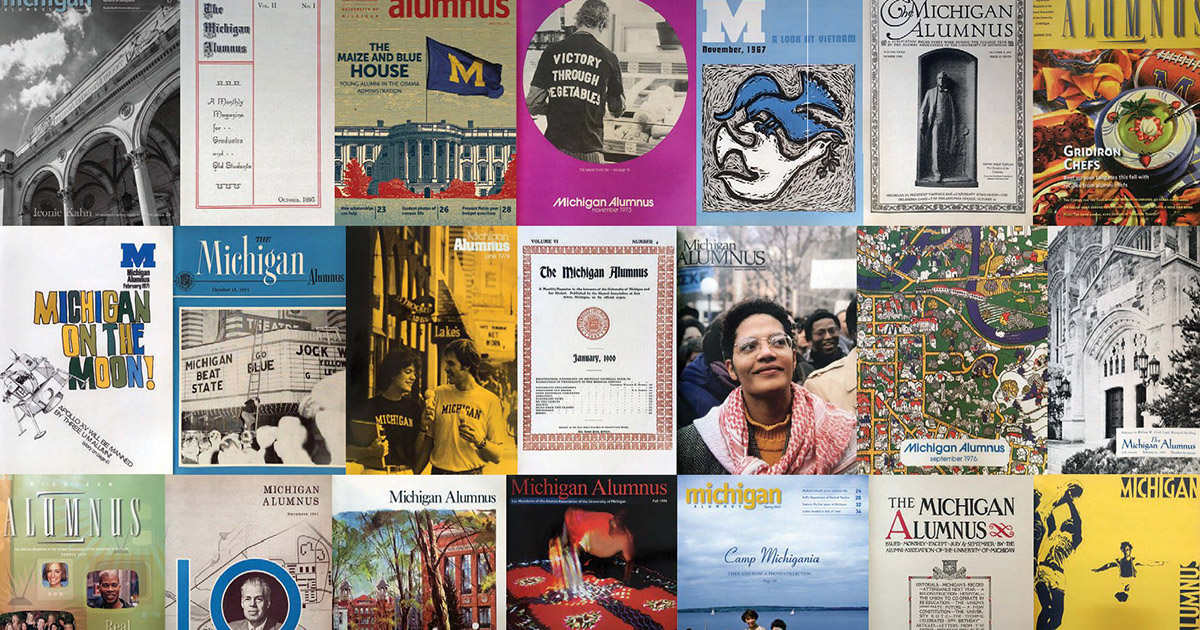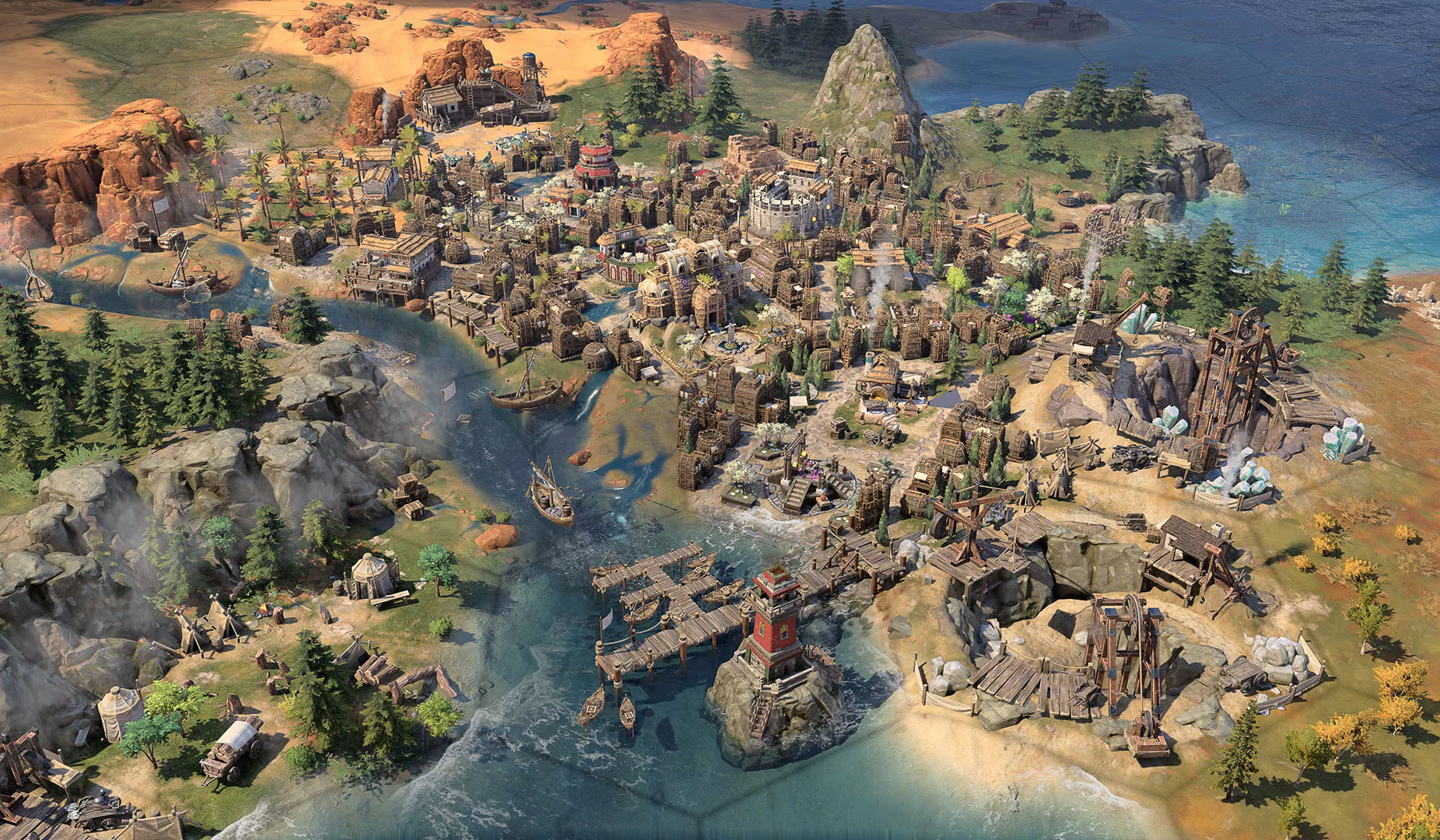In 1894, the University of Michigan—at the time a mere 77 years old—was growing in size and reputation and had become a model for other public universities. But it lacked one thing: an alumni publication that meaningfully connected its readers back to their alma mater. So that year, new graduate Alvick A. Pearson stepped up and published the first issue of Michigan Alumnus. The 16-page, coverless pamphlet provided monthly updates about the University and fellow alumni.
Now, 125 years later, we observe the anniversary of Michigan Alumnus with this timeline, which tracks the history of the University and the Alumni Association through the magazine’s own words. To compile the timeline, the editors turned literally every page of 125 volumes of the magazine and, in the process, learned that it’s impossible to put together an exhaustive list of each moment in history.
If we had unlimited space, you would have seen stories about notable visits to campus (everyone from temperance activist Carrie Nation to composer/pianist Sergie Rachmaninoff), news about alumni (for example, both of Charles Lindbergh’s parents were U-M graduates), updates on campus activities (including a bizarre note that “burying alive” had gone “somewhat” out of fashion as a fraternity initiation), and conflicts like the backlash against students’ automobiles.
So rather than an exhaustive list, the following provides snapshots in time of the past 125 years. Thanks to many of the magazine’s historical articles, we also hear from witnesses to the University’s earliest days. We hope you enjoy.
The words in this timeline are direct from the past articles in Michigan Alumnus. But the photos are not. Rather than scan poor-quality photos, we relied on other sources, such as the U-M Bentley Historical Library, to help illustrate this timeline.
1817: U-M founded in Detroit
1837: U-M moved to Ann Arbor
1841: First students
There were then the four dwelling houses for professors, on the north and south sides of the forty acres of land, constituting the campus, and the two four-storied dormitories at the front or west side. … That great colossus of education, the University of Michigan, was in its early youth, and the immense growth it has since achieved was not then foreseen or imagined.
—Winfield Smith, 1846, shared his memories of campus in an essay from the October 1898 issue of the magazine.
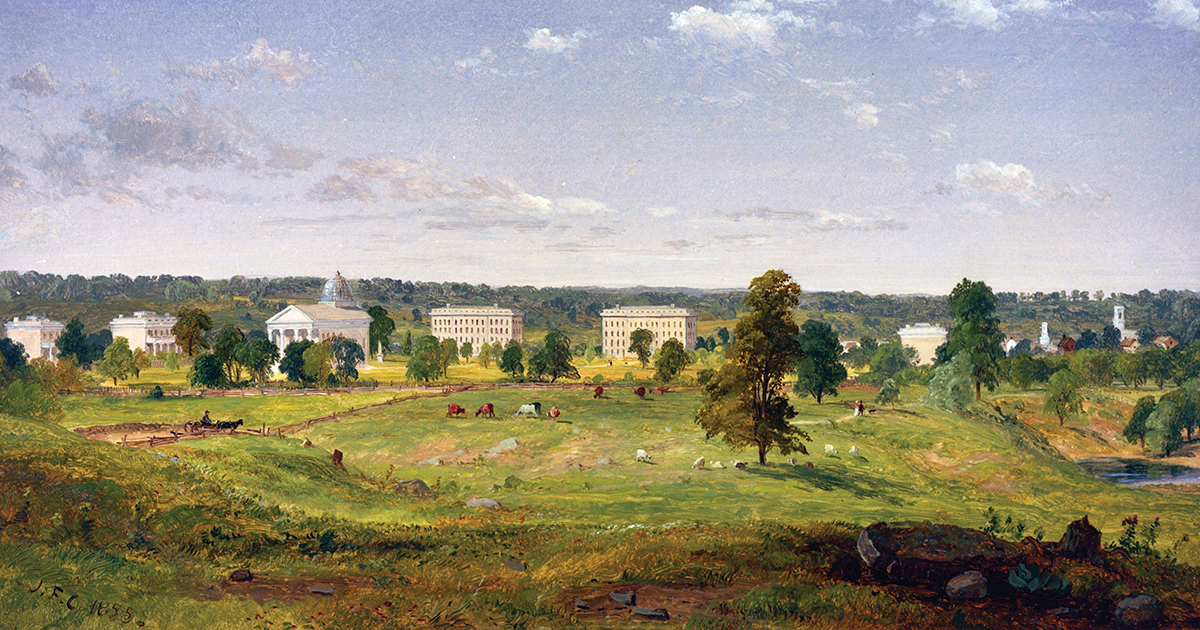
1852-63: Henry Philip Tappan, first president
1854: Research begins
One of the oldest buildings at the University is the Observatory, which dates back to the day of President Tappan’s inaugural address in 1853. The measures that led to the erection and furnishing of this adjunct of the University, originated in a conversation, on that day, between Henry W. Walker of Detroit and President Tappan. Mr. Walker was greatly influenced by the address and the desire came to him to do something to help perpetuate the University. … Mr. Walker raised $15,000, paying $5,000 of the amount himself.
—An article in April 1907 reflected on the money raised following Tappan’s speech, in which he said a “true university” is one dedicated not just to classical education, but research and “higher” learning. Research began at U-M when the first telescope arrived in 1854.
1861: Civil War
Nearly eight hundred students and alumni of Michigan University went to the field during the war, of whom nearly one hundred never returned. Scarcely a battle of importance from Bull’s Run to Appomattox was fought where University students were not present. … They surrendered their college hopes and life plans, and gave their lives to our country freely with others.
—O. B. Curtis, 1865, was a witness to the effect of the Civil War on the U-M campus and described that effect in a June 1897 essay in the magazine.
1863-69: Erastus Otis Haven, second president
1868: First reunion
This rugged old tree was given its name by the class of ’58, who, in order to aid in the work of beautifying the campus, decided that each member of the class should set out a living memorial. Each graduate therefore brought a tree from the woods … and these trees were planted in circles around an oak to which was given the name of Dr. Tappan.
—An article in November 1898 looked back at the reunion of the class of 1858, when alumni returned to campus to inspect the trees class members had planted around the Tappan Oak after their graduation.

1870: Women students
In those days we went to college to study, and the consciousness that we were regarded as an experiment was a potent incentive to us to do our best. Nothing in the old curriculum was changed or modified for us. The roughest and most vociferous of college customs were not in the least abated out of deference to us. But on the other hand, there was no obstacle put in the way of our winning whatever honor we deserved.
—With Madelon Stockwell (middle of second row, with hat), the University enrolled its first female student. Others soon followed and carried an extra responsibility, as Angie Clara Chapin, 1875, described in the June 1902 issue of the magazine.
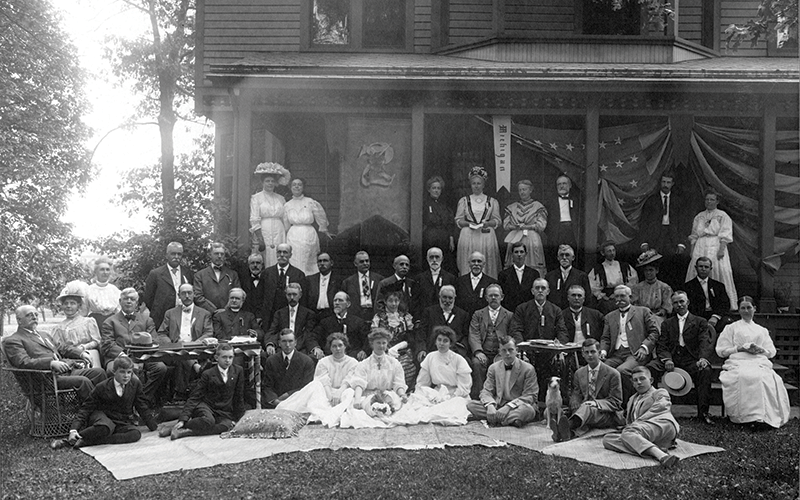
1871-1909: James Burrill Angell, third president
1894: Magazine debuts
The Michigan Alumnus will … devote itself exclusively to the graduate and old student, give him concise and reliable reports of all that should still be attractive to him, discuss with him “ways and means,” give him space and opportunity to suggest improvement or advise retrenchment in the management of our University,—and offers its pages freely as a means of friendly communication between old students of all departments of the University.
—In the first issue of Michigan Alumnus magazine, dated October 1894, editor Alvick A. Pearson, 1894, described the need for a written connection between the University and its alumni.
1897: Alumni Association forms
For some years the desire has been, in the hearts of many of the prominent Alumni of the University of Michigan, to unite the Alumni organizations of all the various departments into one general Alumni Association, which should unite the graduates, regardless of class or department, into one great body; that by united action, they might be able to accomplish some definite good for the University.
—Recognizing the need for a central organization, the departmental alumni societies united to form the Association and purchase Michigan Alumnus magazine.
1898: Spanish-American War
Oliver Burleigh Norton, a member of the medical class of ’01, … was the only Michigan man to fall in battle. He was a private in Roosevelt’s Rough Riders, and was killed by a shell during the charge up the hill at San Juan, Cuba, on July 1st. He died in the arms of his brother.
1901: Yost arrives
Strong individual players he considers very desirable, but experience has taught him that eleven weaker men working together are more efficient. … (He has) reached the hearts of the men, and in turn has been rewarded by their confidence and their efforts to make the most of his instruction.
—With a 165-29-10 record and six national championships, Fielding Yost (wearing his undergraduate Lafayette College sweater in photo) was arguably the best football coach in Wolverine history; he would also serve as athletic director.
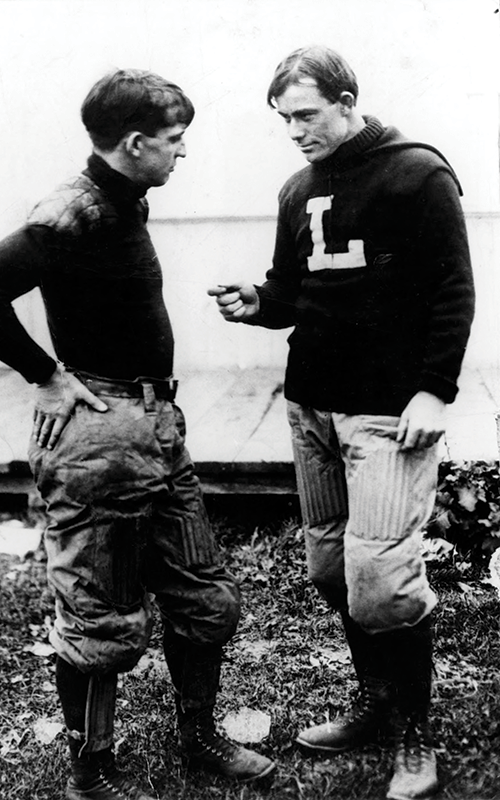
1904: Kahn building
A chief feature of interest on our campus to-day is the new engineering building, the walls of which are now about two stories high. Work on this building was begun in July, 1902, and it is expected to be ready for occupancy sometime during the first semester of 1903-04.
—The Engineering Building, now West Hall, housed a naval tank, the first of its kind affiliated with a university. It was the first major U-M commission for Albert Kahn, who would go on to design some of the University’s most iconic buildings (including Hill Auditorium, Angell Hall, Hatcher Graduate Library, and Burton Memorial Tower).

1909-20: Harry Burns Hutchins, fourth president
1910: Alumni Memorial Hall
The dedication of the Memorial Building marks a new period in the history of the University. It is the first large gift on the part of the alumni to the University, and, in addition, the art exhibition, with which it was formally opened, is the first effective recognition of the fine arts on the part of the University.
—The building would serve as the home of the Alumni Association until its move in 1967 to the Michigan Union and then to the Alumni Center (see 1982). The U-M Museum of Art is the current occupant of the building.
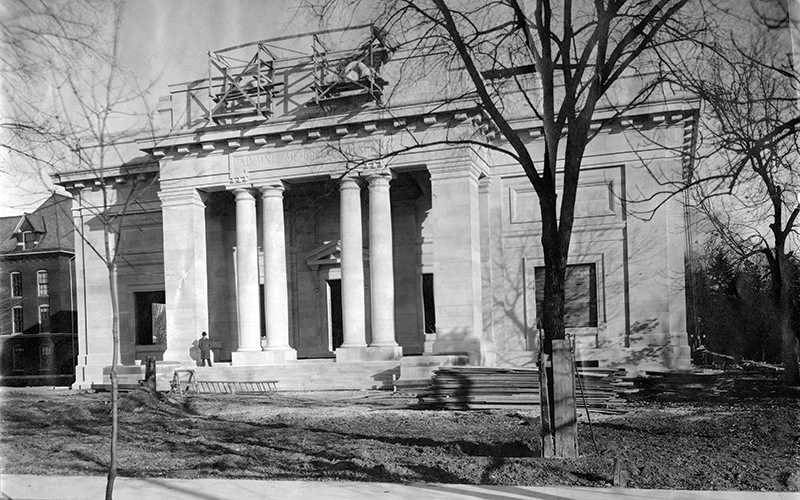
1912: School colors
After a lapse of many years, the University is at last to have official colors. They will be the same azure blue and maize, which we have sung in “The Yellow and the Blue,” for so many years but which, it seems, have never been officially adopted.
—Following the adoption, a committee set out to establish a standard for the color blue; opinions ranged from the “clear blue color of the skies” to “Prussian blue, ultramarine, and smalt.”
1915: Residence halls
An “old-fashioned” dinner given by the Board of Governors of the Martha Cook Building on Tuesday evening, November 2, marked the informal opening of the residence hall. … Dr. Angell was the first speaker at the dinner, telling something of the difficulties of the first women who came to the University in 1869-70.
—The original campus had housing for students. But Henry Tappan questioned their value when he became president in 1852, and the University eventually eliminated them. Martha Cook and Helen Newberry residence halls opened after years of discussion about the need for residence halls on campus.
1917: World War I
The country is in a state of war—real war—such as we have not had for fifty years, and we are no more ready than we were in ’61. What part Michigan is to take in the movement for preparation has become a vital question. In the last days of March steps were taken to place the University among the ranks of other American institutions that are making their resources available for the use of the nation.
—With the entry of the U.S. into World War I, the University—like others around the country—sent its students and faculty off to serve and opened its buildings to train and house soldiers.
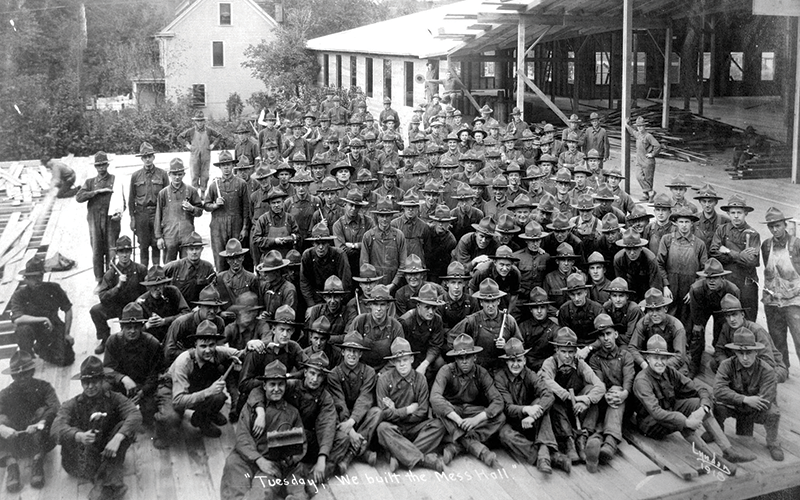
1917: Alumnae organize
Michigan was officially represented at the Biennial Convention of the Association of Collegiate Alumnae held at Washington. … This in itself may not seem unusual except for the fact that they were official representatives of the Alumni Association and were the first delegates of a co-educational institution.
—That year, the Alumnae Council was established. It would go on to raise funds for the Michigan League, provide scholarships, and in many other ways promote the interests of women in the
U-M community.
1919: Michigan Union
Now that the new Union is an accomplished fact, we wonder how the University maintained itself without it for so many years, for already it has become an essential part of the fabric of University life in Ann Arbor.
—Delayed due to World War I, the opening of the Union marked a milestone on campus. Originally formed as a student group in 1904, the Union evolved into a home for the group and, eventually, other organizations.
1920-25: Marion Leroy Burton, fifth president
1921: Football Bust
Be it resolved by the University of Michigan Club of Detroit … (that) we express our pride in, and appreciation for, the Michigan football teams of the past and more particularly at this time, our confidence, in, and loyalty to this year’s team and Coach Yost.
—The magazine published a resolution from the Detroit club supporting Yost after alumni in another city adopted a resolution asking for a new coach. Later that year, the Detroit club held its first Football Bust to honor Yost’s team. The event has been held each year since.
1922: Preview of the review
This publication, it is understood, is in no way to conflict with the Alumnus, but is to include material which this magazine cannot find place for … .
—The Michigan Alumnus Quarterly Review supplemented the weekly Michigan Alumnus until 1962, when it was revamped into the current Michigan Quarterly Review.
1925-29: Clarence Cook Little, sixth president
1925: Clubs meet
So enthusiastically have Michigan alumni seized upon the plan that the Michigan association now boasts of more local clubs than any other similar organization. A triumph in Detroit on June 10-12, will put the final seal upon the effort.
—The magazine announced the First Triennial Convention of the University of Michigan Clubs, a gathering of club leaders from around the world that demonstrated the reach of the Association.
1927: The Big House
Michigan defeated Ohio Wesleyan by a score of 33-0 on Saturday, October 1, in the first game played on the turf of the new stadium. A crowd numbering between 30,000 and 40,000 people … watched the game, and the number would have been much larger but for a downpour which did not end until after the first kickoff, and which left the new gridiron better suited for water-polo than football.

1929-51: Alexander Grant Ruthven, seventh president
1929: Michigan League
From early afternoon, when the reception began, until midnight when the opening formal dance ended, crowds of awed spectators moved from room to room, becoming more impressed with the completeness and beauty of the building. … Thus, at twelve o’clock, when the orchestra played “Home, Sweet Home”, the opening day was over.
—The League provided a space for women, who until 1956 were not officially allowed into the Michigan Union.

1929: Date change
The University suffered a relapse between dawn and dark on the day of May 24, 1929—it aged perceptibly. Early in the day it was a sprightly adult of something over ninety years of age, but before nightfall the ravages of inflicted time had taken their toll and it was a doddering old man of something around one hundred and twelve.
—Wilfred B. Shaw, 1904, the editor of Michigan Alumnus, acknowledged that the U-M board of regents had voted to change the date of the University’s founding to 1817 (when it was established in Detroit) from 1837 (when it moved to Ann Arbor). The sarcasm in his tone reflected his position that the date should remain 1837.
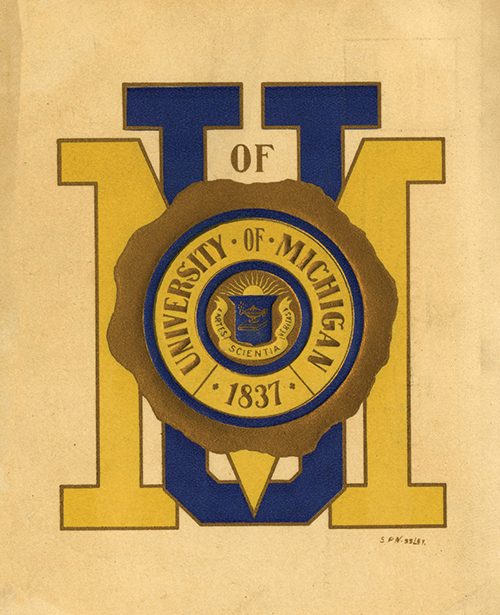
1933: Cooperation participation
Here a group of 22 students are boarding and rooming at a cost of $2 a week. They have a matron, but do all their own house and kitchen work, according to definite schedules.
—The Michigan Socialist House was the first of a wave of co-op-style residences that helped students afford enrollment at U-M.
1934: Law School
Last fall the School moved from its old home on the northwest corner of the Campus to the Law Quadrangle. Thus has come the time for the formal dedication.
—The Law Quad, the entirety of which was the result of the philanthropy of William W. Cook, 1880, JD1882, was dedicated in June 1934.
1937: Centennial
From that point on, as one alumni official smilingly phrased it, the “thing was just out of control.” Registration clerks strove valiantly to handle the throngs of alumni who poured in. The bulletin boards which displayed the rosters of growing class reunion attendance and which were scanned eagerly and constantly by all alumni, were—in the parlance of Wall Street ticker tape devotees—“an hour behind.”
—U-M’s 1937 centennial celebration—based on the date of its move to Ann Arbor rather than its founding in Detroit (see 1929)—was a weeklong affair, culminating in commencement on June 19.
1941: World War II
Only a brief War Department notice, disclosing no details, has been received so far on the death in Hawaii of Benjamin Marsh, Jr., e’36-’38, Grosse Pointe, the first known alumni casualty.
—The notice of Marsh’s death during the attack on Pearl Harbor was part of a broader article on the dangers that soldiers from U-M faced while serving in the Pacific theater of the war.
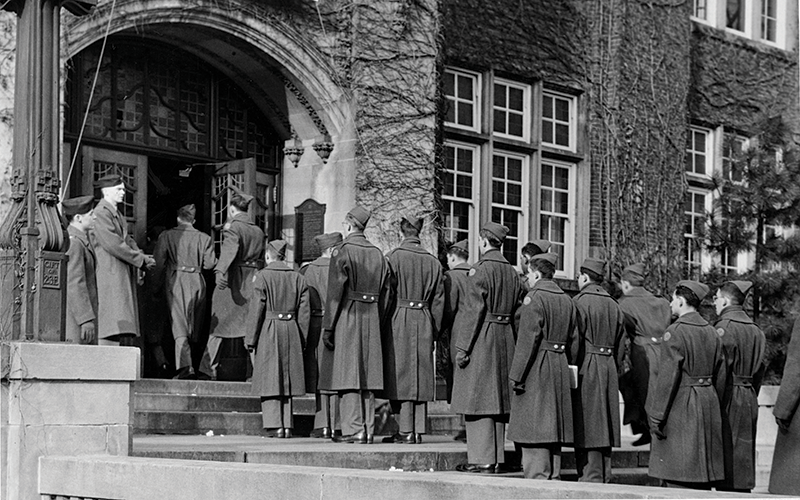
1944: Magazine anniversary
The Michigan Alumnus first appeared just fifty years ago this month. In that fact there is explanation for this special anniversary number and all the flag-waving therein contained. Perhaps the readers will get some entertainment out of this Alumnus self-adulation, and anyway, with the next issue, the magazine will be sane and normal once more and everything will be lovely.
—Marking the magazine’s first 50 years, editor-in-chief T. Hawley Tapping, 1916, mused on its past, present, and future.
1946: Museum of Art
Undoubtedly the dream of everyone concerned with the future of the fine arts at Michigan is of a beautiful museum building designed for its purpose; but until this vision can somehow take on solid form, the Museum will carry on to the best of its bent in the space allotted to it in Alumni Memorial Hall.
—Alumni Memorial Hall, the longtime home of the Alumni Association (see 1910), also became the home of the museum.
1948: Alumni Radio
“Hello Alumni,” a weekly radio program aired over Station WUOM every Thursday from 5:45 to 6:00 P.M., was initiated last month by central office staff members of the Alumni Association. This radio message to alumni listeners in the regional area features Michigan music, interviews with alumni visitors, accounts of alumni club activities, sketch of prominent graduates, and presentation of informal letters of special interest from alumni throughout the world.
1949: The Phoenix Project envisioned
This memorial, “through intensive researches, will demonstrate to the world that Michigan intends to move forward into the new era, determined that the new environment shall benefit and not destroy civilization.”
—The July 16, 1949, issue of the magazine quoted U-M President Alexander Ruthven about the potential of the Michigan Memorial—Phoenix Project, envisioned as a living memorial to the University’s war dead and completed in 1955.
1950: Korean War
The situation is grave and we might have to pull out of Seoul. I hope we do not. The Commission has complete confidence in the ability of the United Nations forces to defeat the enemy and drive him out of Korea in spite of his numerical superiority.
—Bernabe Africa, ’24, PhD’26, wrote to the magazine as chairman of the UN Commission for the Unification and Rehabilitation of Korea about the ensuing conflict.
1951-67: Harlan Hatcher, eighth president
1952: North Campus
“Since the University cannot expand much farther in its present setting, the natural area for its growth is toward the north where the valley of the Huron River and the sloping hills may be used fully in developing a campus of beauty and utility. Both the present campus and the new area may be tied together effectively and at the same time leave ample space for the ongoing growth and progress of Ann Arbor in that section if desired.”
—University President Harlan Hatcher officially unveiled plans for the creation of North Campus at a press conference on Jan. 17, 1952.
1953: Congressional Dinner
Over the years some wonderful celebrations have been staged by University of Michigan Clubs. The famous “National Dinner”, held in New York City on February 4, 1911 … still is cited as the greatest of them all. Not quite so pretentious but nevertheless just as carefully planned and just as efficiently operated—and of the same general character—was the Congressional Reception of the University of Michigan Club of WASHINGTON on January 28. Never since the famous National Dinner have so many of the Michigan alumni members of the Congress of the United States been brought together under the auspices of an alumni organization.
—The event became a breakfast in later years and continues to attract notable alumni in the capital.
1954: Nobel Prize winner
He and his associates were able to establish poliomyelitis virus in cultures of tissue, so much of the work could be done in a test tube instead of having to use monkeys and apes in experiments. Rapid advance in diagnosis and in development of preventive measures resulted, and production of the Salk vaccine was made possible by their original work.
—Thomas H. Weller, ’36, MS’37, HLLD’56, became the first alumnus to win the Nobel Prize, sharing the 1954 prize in medicine and physiology thanks to his contributions to the battle against polio.
1955: Polio Vaccine
On the 12th of last month … Dr. Francis gave his verdict at a meeting attended by scientists and physicians from all over the country. The vaccine worked. It was, he said, 80 to 90 per cent effective against paralytic polio. There were no significant adverse reactions among the children who received it.
—At the meeting, Thomas Francis Jr. (second from left) of the School of Public Health announced the success of the vaccine, developed by his former student Jonas Salk (second from right). Francis had just completed two years of field trials of the vaccine.

1956: Flint Campus
While it has its home in Ann Arbor, President Hatcher asserted that the University was not a tangible thing but rather was a “dedication of spirit” to learning, teaching and research.
—University President Harlan Hatcher welcomed students of the brand new Flint campus on Oct. 9, 1956. In total, 173 students were enrolled in Flint programs that year.
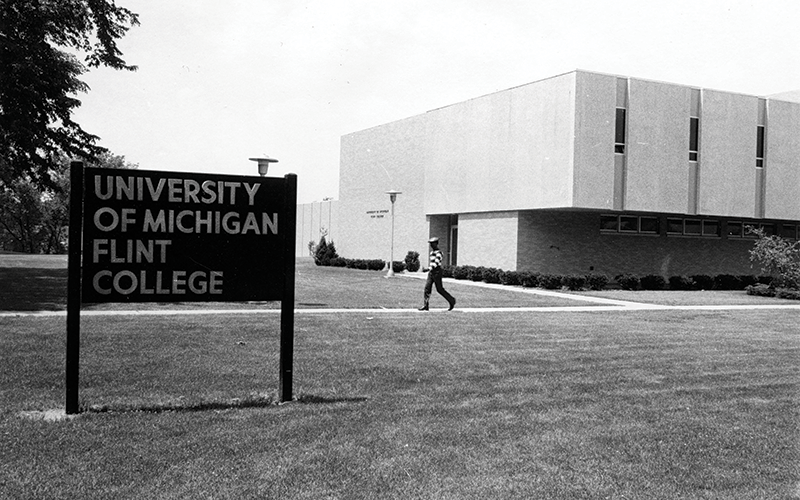
1959: Dearborn Campus
What initial enrollment is anticipated? … We will have about 100 students in Business Administration, 200 in Engineering, and 100 in Literature, Science, and the Arts.
—William E. Stirton, director of the Dearborn Center, answered questions from the editor of the University News Service before the new campus’s September 1959 opening.

1962: Peace Corps
The Peace Corps contingent first arrived at Michigan last October—one year after President Kennedy first made public mention of the Corps during a campaign stop at the University Campus.
—The magazine reported in February 1962 about the contingent that arrived on campus in October 1961, one year after Kennedy’s famous speech on the steps of the Michigan Union.
1962: Alumni Travel
It was Samuel Johnson who once made this observation: “The use of traveling is to regulate imagination by reality, and instead of thinking how things may be, to see them as they are.” A festive group of Michigan Alumni Tour travelers saw things as they are—and as they were—throughout much of Europe last summer. A total of 55 alumni and family members formed the pioneer crew for the first such journey undertaken by the Alumni Association.
—The year 1962 saw the birth of the Michigan Alumni Travel program, which continues to enlighten and enrich U-M graduates. (Pictured is a group traveling the following year.)

1963: Camp fans
“Here’s a testimonial as to the success of the Camp—as I was putting the kids to bed for their last night, they were already talking about coming back next year and asking me if we can. I said it takes money. They sincerely and readily volunteered their allowances, grass-cutting money, etc., to go in the kitty to come back. This, gentlemen, is success!”
—The magazine got plenty of enthusiastic feedback from alumni who attended Camp Michigania during the first full summer at its current location on Walloon Lake. For more about the history of Michigania, see page 6.

1964: Great Society speech
The President gave an address of major importance—one which already is being referred to as the “Great Society address.” The text is also made a part of this issue of the Alumnus. … As the seniors were streaming out through the tunnel, one of them said to me, “We really had ourselves a Commencement!”
1965: First teach-in
In what has been described as the “biggest demonstration in University history,” some 3,000 students filled four Angell Hall auditoria on the night of March 24-25 to hear three lecturers denounce U.S. policy in Viet Nam. … The all-night protest was sponsored by a group called the “Faculty Committee to Stop the War in Viet Nam” and was referred to by the press as a “teach-in.”
—This first teach-in started a movement around the country. The Port Huron Statement—a 1962 manifesto principally written by Tom Hayden, ’61, the co-founder of the Students for a Democratic Society—set the stage for teach-ins when it called for the growth of participatory democracy.
1968-79: Robben Wright Fleming, ninth president
1970: Black Action Movement
A boycott of classroom attendance led by the Black Action Movement, a group of black student organizations and black students, aided and supported by a number of white student organizations and white students. … The major thrust (of BAM’s demands) is that the University guarantee that at least 10 percent of the total University enrollment be black by the 1973-74 academic year.
—BAM’s demands were a precursor to the 2013 Twitter hashtag #BBUM (Being Black at the University of Michigan) student campaign that led to U-M’s board of regents focusing on the enrollment of minority students.
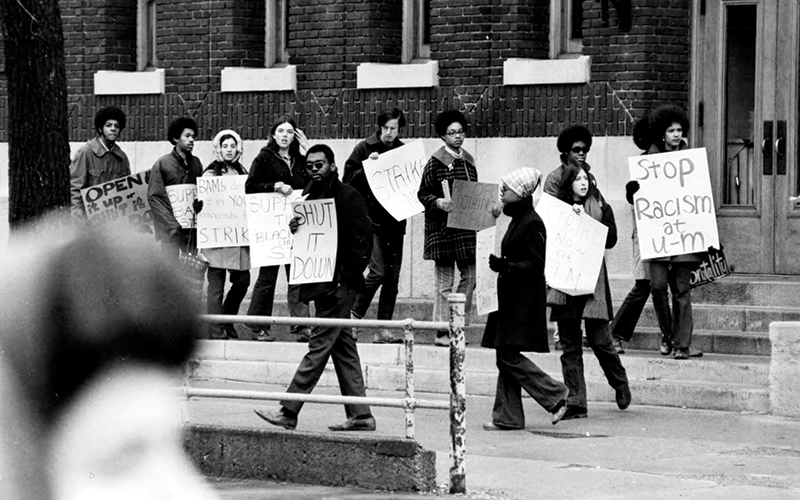
1972: Athena Award
The University of Michigan can well be proud of its alumnae who have contributed lifetimes of commitments to their fellow-man and, in so doing … have brought reflected glory to their own Alma Mater. The Alumnae Council, always a force in the advancement of women, is in the throes of establishing a new honor for a distinguished alumna.
—The Alumnae Council (see 1917) still gives the Athena Award annually to an alumna who distinguishes herself in professional and humanitarian endeavors.
1973: Women’s varsity sports
For the first time in its 156-year history, Michigan women will now compete on an intercollegiate basis in athletics. Female Wolverines will compete against other schools in volleyball, basketball, field hockey, swimming and tennis. Making it all possible is the fact that the University has joined the Association for Intercollegiate Athletics for Women, a step necessary before Michigan could compete on a certified, intercollegiate basis.

1977: Gerald Ford Teaches at U-M
The week of April 4-8 was a busy one for Former President Gerald R. Ford who returned to his alma mater (he is a 1935 U-M graduate) to serve as adjunct professor of political science. During his stay, Ford spoke before 10 political science classes, chatted with students and faculty, visited a U-M spring football practice on Ferry Field, dined at Martha Cook dormitory and filled in for Mrs. Ford (who was unable to accompany him due to illness) as speaker at a local American Cancer Society kick-off luncheon.

1980-87: Harold Tafler Shapiro, 10th president
1982: New Alumni Center
The building is both a symbol and a functional entity—symbolic to the extent that it denotes alumni contributions to the well-being of this University, and functional in that it provides the working environment to continue our many services.
—Bob Forman, then-director of the Alumni Association, conveys his excitement over the opening of the Alumni Center. The building, now undergoing a major interior renovation, will provide an immersive and engaging destination for alumni when it reopens in 2020.

1983: Partial divestiture
Following intensive study, and broad campus discussion and debate, U-M Regents have authorized divestiture of University of Michigan stock in those companies doing business in South Africa—with the exception of corporations headquartered in Michigan or providing substantial employment in the state.
—In 1988, U-M’s board of regents voted to sell the University’s remaining investments in South Africa in opposition to apartheid and racial injustice.
1984: 90th anniversary
Our current view of the magazine is, indeed, to create a “spirit” among our former students which will enable them to better understand and support their University. At the same time, we sense that there is an obligation for the continuing education and enrichment of Alumni Association members. The magazine today is a blend of those objectives. … It is your magazine and your inputs are invaluable to us.
—Bob Forman, who retired in 1994 after 28 years as director of the Alumni Association, called for reader engagement with Michigan Alumnus.
1985: Honoring Raoul Wallenberg
Student, diplomat, rescuer, prisoner, Raoul Wallenberg, ’35arch, was all of these. Generous in spirit, clever in intellect, this determined young man skillfully won freedom—and therefore life—for thousands of Jews in Budapest, Hungary during the final days of World War II. Forty years after Wallenberg disappeared en route to meet with a Russian commander following Soviet occupation of Budapest, Michigan Alumnus traces his story from his native Sweden to this midwestern campus, to Budapest, and finally, his uncertain fate in Soviet prisons.
1988-96: James Johnson Duderstadt, 11th president
1991: Gulf War
It’s funny sometimes how people are drawn together during difficult times. Well, three of us here supporting the international fight against Saddam Hussein were drawn together by our love for the Maize and Blue! … Our jobs are different, but our goals are very much the same: that is a peaceful resolution to this crisis.
—Capt. David E. Lang, ’85, wrote to the magazine while serving with Operation Desert Storm.
1996-2001: Lee C. Bollinger, 12th president
2001: Sept. 11
(The) morning of Sept. 23 … I attended a memorial service for Jim Gartenberg, ’87, who was trapped on the 86th floor of the North Tower of the World Trade Center when it collapsed. Half of the standing-room-only crowd wore “M” lapel pins; some of his friends wore Michigan caps in lieu of yarmulkes: more than one speaker referred to Jim’s commitment to his family, his work and his University; and during her remarks, his wife, Jill, ’89, held up the Michigan jersey that Jim faithfully wore each Saturday in the fall.
—Steve Grafton, president and CEO of the Alumni Association since 1994, reflected on the impact of the terrorist attack on the U-M family. Eighteen alumni died that day.

2002-14: Mary Sue Coleman, 13th president
Meet Mary Sue Coleman, the 13th president of the University of Michigan, who began her term on Aug. 1. … She has a big agenda in front of her, including filling four vacant vice president positions, defending the U-M in two admission lawsuits and leading the University’s Life Sciences initiative.
—With Coleman’s arrival from the University of Iowa, U-M welcomed its first female president.
2003: Supreme Court ruling
On June 23, the Supreme Court ended the University of Michigan’s six-year, $10 million legal battle over its admissions policies, upholding the U-M’s admissions policy in the Law School case 5-4 and striking down the University’s undergraduate policy on a 6-3 ruling. At issue in both lawsuits was the use of race in admissions. The win means that race can continue to be used in admissions but the use must be “narrowly tailored.”
—In 2006, Michigan voters passed Proposal 2, which banned preferential treatment to groups or individuals based on their race, gender, color, ethnicity, or national origin for public employment, education, or contracting purposes. In 2014, the U.S. Supreme Court upheld Proposal 2.

2008: Diag Commencement
An email from U-M Officials confirmed graduating students’ choice of the Diag as the location for spring commencement. Students were polled after the University received negative feedback about plans to hold commencement in Rynearson Stadium at nearby Eastern Michigan University. The ceremony could not be held at Michigan Stadium due to ongoing construction.
2014-present: Mark S. Schlissel, 14th president
2016: Winningest coach
Michigan softball coach Carol Hutchins became the sport’s all-time NCAA winningest coach on April 2 with an 8-0 Wolverine win over Indiana. It was her 1,458th victory in 33 years of coaching, all but one of them at U-M, where she has been named Big Ten Coach of the Year 15 times. “I told them, ‘This is not about me; this is about us,” Hutchins said to The Michigan Daily, shortly after the historic win. “I think my team continues to represent every woman who’s ever played before them.”
2017: Bicentennial
The Spirit of Detroit statue helped the University celebrate its 200th anniversary of its founding on Aug. 26 by donning a special bicentennial T-shirt. Located in downtown Detroit, the statue is just blocks away from the corner of Bates and Congress streets, where the University of Michigan first stood in 1817 (before moving to Ann Arbor in 1837). To celebrate the anniversary of its birth, U-M hosted a festival Sept. 15 in downtown Detroit.
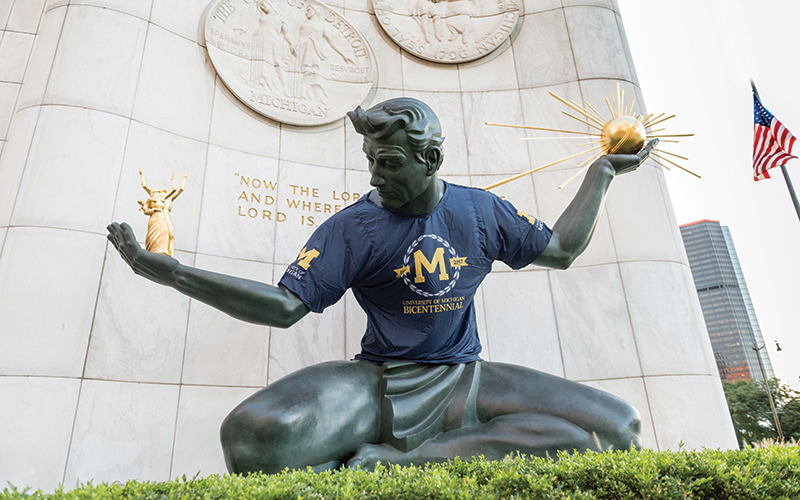
2017: Go Blue Guarantee
In June, on the heels of a campuswide effort to promote diversity, the U-M board of regents approved the Go Blue Guarantee scholarship program to help attract students from different backgrounds, not just those from well-to-do families. Starting with the winter 2018 semester, the program offers four years of free tuition to in-state students on the Ann Arbor campus whose families earn $65,000 or less and have less than $50,000 in assets.
2018: LEAD Scholars
In celebration of the 10th anniversary of the Alumni Association’s LEAD Scholars Program, Michigan Alumnus is featuring a four-part series in which we follow a LEAD scholar during her first year at Michigan. … The LEAD Scholars Program provides scholarships to black, Latino, and Native American students who have been accepted into U-M.
2018: A Capital Campaign
U-M has not only met the goal but far surpassed it. With more than $5 billion raised as of this past October, the University also shattered fundraising records for public universities. … For its part, the Alumni Association also set its own fundraising record with $65 million in gifts that will support several program areas.
Jennifer Conlin, ’83, Gregory Lucas-Myers, ’10, and Sharon Morioka, ’84, MA’86, are the editors of Michigan Alumnus.
Campus Painting, Reunion Tree, Madelon Stockwell, Fielding Yost, Kahn Building, Alumni Memorial Hall, World War I, Stadium, Michigan League, Date Change, World War II, Flint, Dearborn, Polio, BAM, Varsity Sports, Gerald Ford, and Alumni Center photos courtesy of U-M Bentley Historical Library | Affirmative action photo by Martin Vloet/Michigan Photography | Bicentennial Photo by Scott C.Soderberg/Michigan Photography

